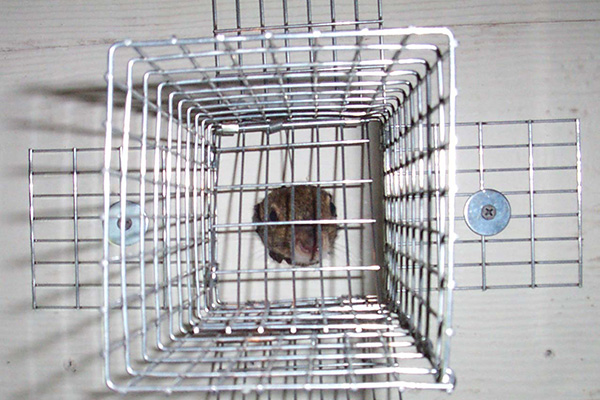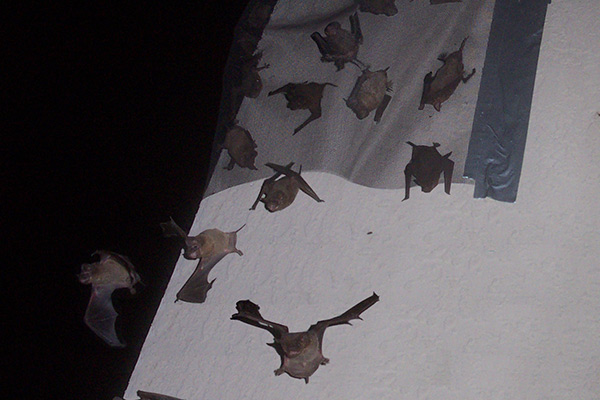- info@animalatticpest.com
- Call - we service 300 locations

Wildlife Exclusion Using One-Way Doors
In many cases, you can simply exclude the animals from the attic, without actually trapping them in cages. This technique works well in many squirrel situations, and even some raccoon, rat, bird, or opossum cases. It is the ONLY way to do a bat removal job. So instead of trapping squirrels or raccoons, consider excluding them with a one-way door. Here's the principle: the animals in your attic exit and re-enter the attic several times each day. They have to get water and food. So all you have to do is isolate their primary entry hole, and mount a special one-way door over it. This door allows the animals to exit, but not get back in. This technique is best when you are certain that the animals, once outside, won't be able to find their way back in again. You must have a sturdy home with no vulnerable areas. Also, you must make sure that there are no baby animals trapped inside. If there are, a squirrel will desperately chew everywhere on your house. Nothing will stop a mother raccoon - she'll tear your house apart to get back to her babies. As for bats, you cannot perform an exclusion during the summer maternity season, when the attic is full of flightless baby bats. Once the animals are out of the attic with an exclusion, they are still in their native territory, just not inside your attic. This is easier on the animals, and on you!
Wildlife Exclusion Using One-Way Doors
Example Set on a Squirrel Hole
Here you can see a one-way exclusion door mounted on a squirrel hole. If you are confident that the animals won't be able to chew their way back in, this is the best method.
A Squirrel Coming Out
They push their way through the spring-loaded door, but then can't get back in. If you are going to use this technique, be sure that the baby squirrels are mobile and able to push through.
A Repeater Trap
This is a type of trap which works on the same principle as the one-way door, but it has an enclosed cage, so the squirrels get trapped. A one way door simply has an open end, so they get out.
Information About Wildlife Exclusion Using One-Way Doors
Reasons To Consider One-Way Doors
By using one-way doors, you will not have to come into any contact with the wildlife in question. Instead, you do everything when they are not present or without getting too close. This minimizes the risk of bites, scratches, or contracting a disease. Additionally, one-way doors are easier on the animal than trapping and relocation since they will be familiar with the area around your property. While relocation does work sometimes, it is frequently impossible or incredibly challenging for the wild animal in question to find food, water, and shelter. This reduces their chances of survival, but with exclusion, they will be in a familiar area and know where to find these things.
How To Use One-Way Doors
The process of using a one-way door is relatively straightforward. You begin by sealing up every entry point to the area except for the main one. After that, you place an exclusion device like a one-way door over the remaining entrance. The animals should be able to leave the location but not get back inside if it is set up correctly. After a few days, check whether all the wildlife is out of your property. Then, you can remove the one-way door and seal up the final hole. After this, you will just have to clean up the space to remove all traces of the wildlife. This is an essential step for preventing disease and bad smells, including those that could attract other wildlife.
Leave It To The Pros
It is possible to do wildlife exclusion with a one-way door yourself, but it is very easy to miss an entrance if you are not familiar with what to look for. Since a single open entrance will leave the way open for more wildlife to get inside – or the ones you evicted to return – you need to find and seal every single hole. A professional will be able to do this much more easily as they know signs of an entry point and simply have more experience finding them. Additionally, exclusion frequently involves climbing ladders to find and seal entry points, which can be dangerous and is best left to the professionals.
No matter the type of wildlife you have in your home or building, you will want to get it out of your space as soon as possible. This minimizes the amount of damage the wildlife can do to your property as well as the health risks associated with it. While some people automatically turn to trapping and relocation as the answer, one-way doors are a much better alternative.
And don't forget that you can use this technique on the chimney cap. Read All About Animals In The Chimney.
The Bottom Line
One-way exclusion doors are a nice alternative to trapping, because it is easy on the animals. They are able to live in their native environment - they are simply blocked out of the attic. It's also easy on you, because you don't have to deal with a trapped animal in a cage, and the relocation process. You just have to make sure to do an exclusion in the right circumstances, with no other possible entry back into the attic, and with no helpless immobile baby animals inside the house.




